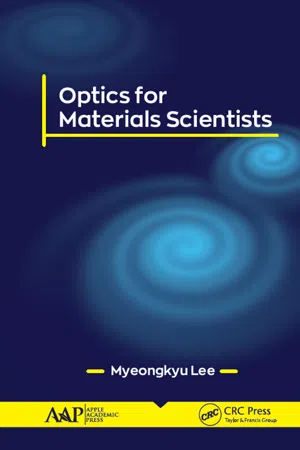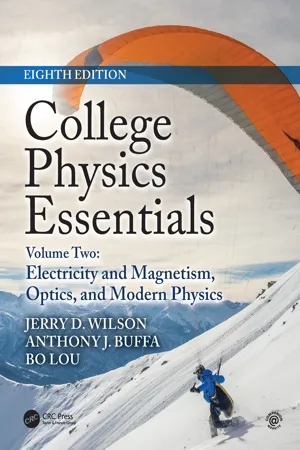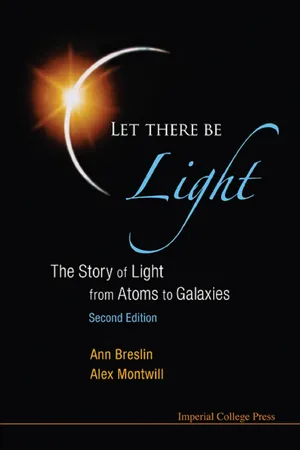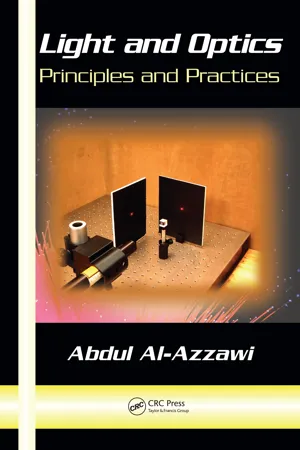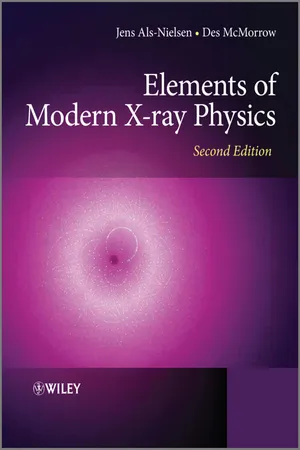Physics
Refraction
Refraction is the bending of light as it passes from one medium to another, such as from air to water or glass. This bending occurs because light travels at different speeds in different materials. The change in speed causes the light to change direction, resulting in the familiar phenomena of objects appearing shifted when viewed through water or a lens.
Written by Perlego with AI-assistance
Related key terms
Related key terms
1 of 4
Related key terms
1 of 3
7 Key excerpts on "Refraction"
- eBook - ePub
- Myeongkyu Lee(Author)
- 2019(Publication Date)
- Apple Academic Press(Publisher)
CHAPTER 2Reflection and Refraction
2.1 INTRODUCTION
In this chapter, we describe a variety of phenomena occurring when a light wave passes from one medium to another. Consider a wave impinging on the interface separating two different media. As we already know from daily life, a portion of the incident energy bounces off the interface in the form of a reflected wave, while the remainder is transmitted across the boundary. When the wave is obliquely incident onto the interface, it is partially reflected and partially refracted. Refraction refers to the change in propagation direction of a wave when it enters a medium of different refractive index. The phenomenon is mainly governed by the law of energy and momentum conservation. It is commonly observed when a wave passes from one medium to another at any angle other than 0° from the normal. Light Refraction is the most commonly observed phenomenon, but any type of wave can be refracted when it interacts with a medium. Refraction is also responsible for rainbows and for the splitting of white light into a rainbow-spectrum as it passes through a glass prism. A long object such as a pencil or wood stick obliquely immersed in water looks bent due to Refraction. This is because a light ray reflected from the tip of the object refracts as it leaves the surface of water. Thus, the ray conceived by our eyes looks as if it were reflected from a point other than the tip of the object. Understanding of this concept led to the invention of lenses and glasses.The Refraction of light is quantitatively described by Snell’s law. This law represents the relationship between the angles of incidence and Refraction, when a light wave passes through a boundary between two isotropic media with different refractive indices. Snell’s law can be derived from Fermat’s principle or the application of boundary conditions for electromagnetic waves. The detailed behaviors of reflection and Refraction in a given situation are well explained by the Fresnel equations, which describe what fraction of the incident light is reflected and what fraction is refracted (i.e., transmitted) at a planar interface separating two optical media. They also describe the phase shift of the reflected light. It will be shown that all these quantities depend not only on the change in refractive index and the angle of incidence, but also the polarization state of the incident light. This chapter treats the general features associated with the propagation, reflection, and Refraction of light in isotropic media. These media are assumed to be linear, homogeneous, and nonmagnetic. As discussed in Chapter 1 - eBook - ePub
College Physics Essentials, Eighth Edition
Electricity and Magnetism, Optics, Modern Physics (Volume Two)
- Jerry D. Wilson, Anthony J. Buffa, Bo Lou(Authors)
- 2019(Publication Date)
- CRC Press(Publisher)
° (step 4). This is the final direction of the ray reflected after both mirrors.What if the directions of the rays are reversed? In other words, if a ray is first incident on M 2 , in the direction opposite that of the one drawn in step 4, will all the rays reverse their directions? Draw another diagram to prove that this is indeed the case. Light rays are reversible.Follow-Up Exercise. When following an eighteen-wheel semitrailer, there may be a sign on the back stating, “If you can’t see my mirror, I can’t see you.” What does this mean? (Answers to all Follow-Up Exercises are given in Appendix V at the back of the book. )22.3 RefractionRefraction refers to the change in direction of a wave at a boundary where the wave passes from one medium into another. In general, when a wave is incident on a boundary between media, some of the wave’s energy is reflected and some is transmitted. For example, when light traveling in air is incident on a transparent material such as glass, it is partially reflected and partially transmitted (▼ Figure 22.10 ). But the direction of the transmitted light is different from the direction of the incident beam, so the light is said to have been refracted; in other words, it has changed direction.▲Figure 22.10Reflection and Refraction A beam of light is incident on a rectangular glass from the left. Part of the beam is reflected, and part is refracted at the air–glass surface. The refracted beam is again partially reflected and partially refracted at the bottom glass–air surface (right).This change in direction is caused by the fact that light travels with different speeds in different media. Intuitively, you might expect the passage of light to take longer through a medium with more atoms per volume, and the speed of light is, in fact, generally less in denser media. For example, the speed of light in water is about 75% of that in air or a vacuum.The change in the direction of wave propagation is described by the angle of Refraction . In ▼ Figure 22.11 , Refraction of light at a medium boundary, θ 1 is the angle of incidence and θ 2 is the angle of Refraction. The symbols θ 1 and θ 2 are used for the angles of incidence and Refraction so as to avoid confusion with θ i and θ r , the angles of incidence and reflection. Willebrord Snell (1580–1626), a Dutch physicist, discovered a relationship between the angles (θ ) and the speeds (v - eBook - ePub
Let There Be Light
The Story of Light from Atoms to Galaxies
- Ann Breslin, Alex Montwill(Authors)
- 2013(Publication Date)
- ICP(Publisher)
Chapter 3Light as a Ray: RefractionProviding more than one quickest routeWhen light crosses the boundary between two media, it changes direction. This phenomenon is called Refraction. In this chapter we study the rules and applications of Refraction. The basic rule is the same as always: it is Fermat’s principle of least time. We show that the principle leads to the experimentally established Snell’s law of Refraction.Lenses are the most common example of the application of the laws of Refraction. In making a lens, the trick is to make the shape such that all routes from a source A to a destination B on the other side of the lens take the same time, despite the fact that light traverses different thicknesses of glass on different routes.We spend the remainder of this section dealing with the geometry of the paths, and derive some simple formulae for lenses.Making visible things we cannot seeWe describe the effect of various combinations of lenses which make up optical systems. One fascinating example is the optical system of the human eye. We discuss some common eye defects and how these may be corrected using suitable lenses.Finally, we describe optical systems which enable us to look at things which are either too small or too far away to be seen with the naked eye. 3.1 RefractionThe refractive indexAs we all know, from experience of city traffic, if the speeds along different routes are not the same, the shortest route is not necessarily the quickest. We have seen already that in vacuum the speed of light is fixed at c = 2.99792458 × 108 m/s, equivalent to travelling a distance of approximately 7.5 times around the earth in one second. Light can also travel through certain ‘transparent’ materials such as air, water, glass or quartz, and there the speed is less than c. The refractive index - Bill Woodward(Author)
- 2014(Publication Date)
- Sybex(Publisher)
medium is any material or space through which electromagnetic radiation can travel.How quickly light travels through a medium is determined by its refractive index. Light travels more slowly in a material with a high refractive index and faster in a material with a low refractive index. It is important to note that even though light slows down when passing from a medium with a lower refractive index into a medium with a higher refractive index, it speeds up again when it passes into a medium with a lower refractive index (see Figure 3.6 ).Light changes speeds as it passes through mediums with different refractive indexes.Figure 3.6When light changes velocity as it travels from one medium into another, Refraction occurs. The amount of Refraction is determined by the relative difference in the light's velocity in each of the media. The greater the difference, the greater the Refraction.In Figure 3.5 , shown earlier, the portion of the oar in the water looks bent because the light rays reflected from it are bent as they pass through the boundary between the water and the air, as seen in Figure 3.7 . Notice also that the portion of the oar that is underwater is distorted because the light rays reflected from it have been bent.Light rays from the oar are refracted as they pass from water into the air.Figure 3.7To explain Refraction, we have to look at the wave nature of light. Recall that light consists of two perpendicular waves, and that the light travels in a path that forms right angles with both waves.As the light wave meets the boundary between media with different refractive indexes, that portion of the light wave changes velocity or it experiences a phase velocity change, while the rest of the light wave maintains its original velocity. A change in the phase velocity of a light wave typically causes the light wave to change direction as described by Snell's law, which is discussed in detail later in this chapter. Figure 3.8- eBook - ePub
Light and Optics
Principles and Practices
- Abdul Al-Azzawi(Author)
- 2018(Publication Date)
- CRC Press(Publisher)
Equation (7.9) , gives the following equation:n 1sinθ i=n 2sinθ refr(7.10) where n1 and n2 are the index of Refraction for medium 1 and 2, respectively. The relationship between these angles is known as the law of Refraction, or Snell’s law.More generally, the following relationships for light Refraction in an optical medium can easily be determined from Snell’s law:1. When a light ray enters a denser medium, its speed decreases, and the refracted ray is bent towards the normal. For example, this occurs when the light ray moves from air into glass, as shown in Figure 7.8 .2. When a light ray enters a less dense medium, its speed increases, and the refracted ray is bent away from the normal. For example, this occurs when the light ray moves from glass into air, as shown in Figure 7.9 .3. There is no change in the direction of propagation, if there is no change in index of Refraction. The greater the change is in the index of Refraction the greater the change in the propagation direction will be.4. If a light ray goes from one medium to another along the normal, it is undeflected, regardless of the change in the index of Refraction, as shown in Figure 7.10 . Although the angle does not change, the speed of light does change as the light travels from one medium to another.FIGURE 7.8 Light ray propagates from air into glass.FIGURE 7.9 Light ray propagates from glass in to air.FIGURE 7.10 Normal incident light ray passes through differenct optical materials.The principles of reflection and Refraction are illustrated in Figure 7.6 . An incident light ray is partially reflected and partially refracted, and then transmitted at the interface plane, separating two transparent media.Figure 7.11 shows a light ray passing through two media (air and glass). The change in index of Refraction at each interface causes the incident ray to bend twice. This figure also shows that the angle θ1 equals the angle θ3 - eBook - ePub
- Jens Als-Nielsen, Des McMorrow(Authors)
- 2011(Publication Date)
- Wiley(Publisher)
Chapter 3 Refraction and reflection from interfacesA ray of light propagating in air changes direction when it enters glass, water or other transparent materials. This is the basis for the classical optics of lenses. Quantitatively, the phenomenon is described by Snell’s law. For visible wavelengths the refractive index n of most transparent materials has a value in the range between 1.2 and 2. The refractive index depends on the frequency ω of the light, so that blue light is refracted more than red light, etc.The index of Refraction for electromagnetic waves displays resonant behaviour at frequencies corresponding to electronic transitions in atoms and molecules. On the low frequency side of a resonance, n increases with ω, and this is known as normal dispersion. Immediately above the resonance frequency it decreases, and as more and more resonances are passed, the magnitude of the index of Refraction decreases. X-ray frequencies are usually higher than all transition frequencies, perhaps with the exception of those involving the inner K- or maybe L-shell electrons. As a result in the X-ray region n turns out to be less than unity. (See Fig. 1.8 and accompanying discussion.) This reflects the phase shift of π in the Thomson scattering of X-rays, as we shall see. Moreover, it leads to the phenomenon of total external reflection from a flat, sharp interface: for incident glancing angles α below a certain critical angle αc the ray will no longer penetrate into the material but will be totally reflected from it. The deviation of n from unity is tiny, so the critical angle is small. The reader might wonder how n can be less than unity, since the velocity in the material is c /n , and this would seem to imply that the speed of light is higher in the material than in vacuum. However, c /n is the phase velocity, not the group velocity. The latter, evaluated as d ω/d k, is indeed less than c - eBook - ePub
Making Physics Fun
Key Concepts, Classroom Activities, and Everyday Examples, Grades K?8
- Robert Prigo(Author)
- 2015(Publication Date)
- Skyhorse(Publisher)
Again, ignoring all reflections, the beam would bend further toward the normal each time it propagated from one substance to the next. Indeed, if the layers were all very thin, the ray would appear to curve continuously through them. This is exactly what happens when light from the sun refracts through the atmosphere on the way to the earth’s surface. Since the index of Refraction decreases with elevation due to the thinning atmosphere, light rays curve downward toward the surface. See “Activities” and “Everyday Examples” for more cases of light curving.Figure 4.14Now consider a prism-shaped piece of glass (or water, diamond, etc.) placed in air (or in some other substance of lower index). Ignoring all reflections, Figure 4.15 follows the two Refractions, first at the air-to-glass boundary and then at the glass-to-air boundary.In the first case, the ray bends toward the normal (normals are shown as dashed lines). In the second case, the ray bends away from the normal. Unlike the pane of glass, the prism shape deflects the light ray significantly from its original path. For this reason, glass prisms are commonly used by scientists and engineers to change the direction of a light beam. For fun, consider a prism-shaped air pocket inside a chunk of glass. How would the two Refractions, entering the air pocket and leaving the air pocket, be different from the glass prism case? Which way would the ray be deflected?Figure 4.15Now consider a circular glass lens (shown edge on) surrounded by air, with one side a flat surface and the other side a convex surface (a plano-convex lens), as shown in Figure 4.16 .Figure 4.16Three parallel rays, representing a beam of light, are incident on the lens from the left. All three rays pass straight through the flat side, since there is no Refraction when a light ray enters perpendicular to the surface. As the three rays emerge from the convex side, the center ray passes straight through, since it is incident directly along the normal to the glassair interface, while the upper ray is bent downward (bending away from the normal) and the lower ray is bent upward (bends away from the normal).
Index pages curate the most relevant extracts from our library of academic textbooks. They’ve been created using an in-house natural language model (NLM), each adding context and meaning to key research topics.
Explore more topic indexes
Explore more topic indexes
1 of 6
Explore more topic indexes
1 of 4
